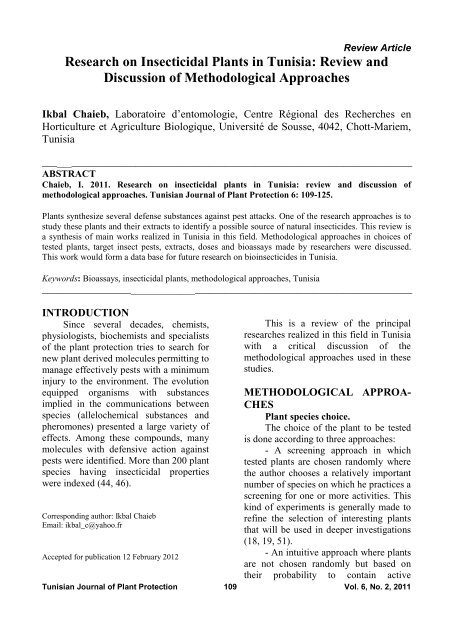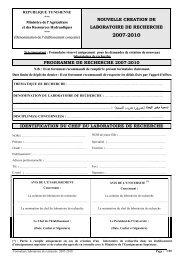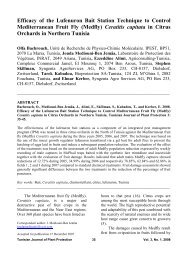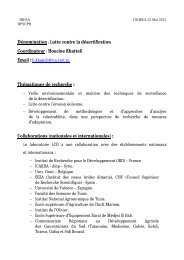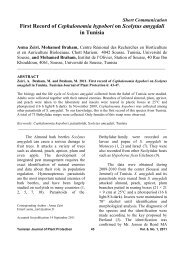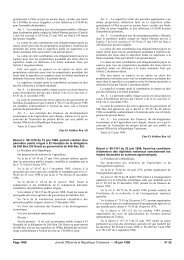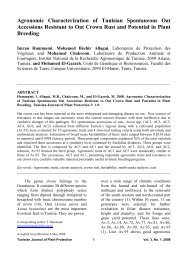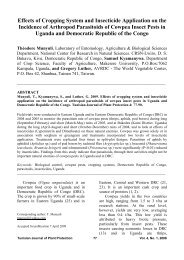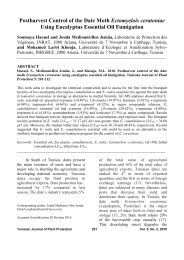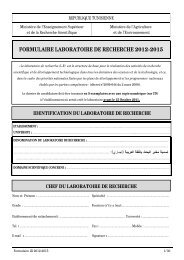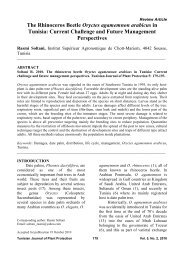Research on Insecticidal Plants in Tunisia: Review and ... - Iresa
Research on Insecticidal Plants in Tunisia: Review and ... - Iresa
Research on Insecticidal Plants in Tunisia: Review and ... - Iresa
Create successful ePaper yourself
Turn your PDF publications into a flip-book with our unique Google optimized e-Paper software.
<strong>Review</strong> Article<br />
<str<strong>on</strong>g>Research</str<strong>on</strong>g> <strong>on</strong> <strong>Insecticidal</strong> <strong>Plants</strong> <strong>in</strong> <strong>Tunisia</strong>: <strong>Review</strong> <strong>and</strong><br />
Discussi<strong>on</strong> of Methodological Approaches<br />
Ikbal Chaieb, Laboratoire d’entomologie, Centre Régi<strong>on</strong>al des Recherches en<br />
Horticulture et Agriculture Biologique, Université de Sousse, 4042, Chott-Mariem,<br />
<strong>Tunisia</strong><br />
___________________________________________________________________________<br />
ABSTRACT<br />
Chaieb, I. 2011. <str<strong>on</strong>g>Research</str<strong>on</strong>g> <strong>on</strong> <strong>in</strong>secticidal plants <strong>in</strong> <strong>Tunisia</strong>: review <strong>and</strong> discussi<strong>on</strong> of<br />
methodological approaches. <strong>Tunisia</strong>n Journal of Plant Protecti<strong>on</strong> 6: 109-125.<br />
<strong>Plants</strong> synthesize several defense substances aga<strong>in</strong>st pest attacks. One of the research approaches is to<br />
study these plants <strong>and</strong> their extracts to identify a possible source of natural <strong>in</strong>secticides. This review is<br />
a synthesis of ma<strong>in</strong> works realized <strong>in</strong> <strong>Tunisia</strong> <strong>in</strong> this field. Methodological approaches <strong>in</strong> choices of<br />
tested plants, target <strong>in</strong>sect pests, extracts, doses <strong>and</strong> bioassays made by researchers were discussed.<br />
This work would form a data base for future research <strong>on</strong> bio<strong>in</strong>secticides <strong>in</strong> <strong>Tunisia</strong>.<br />
Keywords: Bioassays, <strong>in</strong>secticidal plants, methodological approaches, <strong>Tunisia</strong><br />
___________________________________________________________________________<br />
INTRODUCTION<br />
S<strong>in</strong>ce several decades, chemists,<br />
physiologists, biochemists <strong>and</strong> specialists<br />
of the plant protecti<strong>on</strong> tries to search for<br />
new plant derived molecules permitt<strong>in</strong>g to<br />
manage effectively pests with a m<strong>in</strong>imum<br />
<strong>in</strong>jury to the envir<strong>on</strong>ment. The evoluti<strong>on</strong><br />
equipped organisms with substances<br />
implied <strong>in</strong> the communicati<strong>on</strong>s between<br />
species (allelochemical substances <strong>and</strong><br />
pherom<strong>on</strong>es) presented a large variety of<br />
effects. Am<strong>on</strong>g these compounds, many<br />
molecules with defensive acti<strong>on</strong> aga<strong>in</strong>st<br />
pests were identified. More than 200 plant<br />
species hav<strong>in</strong>g <strong>in</strong>secticidal properties<br />
were <strong>in</strong>dexed (44, 46).<br />
Corresp<strong>on</strong>d<strong>in</strong>g author: Ikbal Chaieb<br />
Email: ikbal_c@yahoo.fr<br />
Accepted for publicati<strong>on</strong> 12 February 2012<br />
This is a review of the pr<strong>in</strong>cipal<br />
researches realized <strong>in</strong> this field <strong>in</strong> <strong>Tunisia</strong><br />
with a critical discussi<strong>on</strong> of the<br />
methodological approaches used <strong>in</strong> these<br />
studies.<br />
METHODOLOGICAL APPROA-<br />
CHES<br />
Plant species choice.<br />
The choice of the plant to be tested<br />
is d<strong>on</strong>e accord<strong>in</strong>g to three approaches:<br />
- A screen<strong>in</strong>g approach <strong>in</strong> which<br />
tested plants are chosen r<strong>and</strong>omly where<br />
the author chooses a relatively important<br />
number of species <strong>on</strong> which he practices a<br />
screen<strong>in</strong>g for <strong>on</strong>e or more activities. This<br />
k<strong>in</strong>d of experiments is generally made to<br />
ref<strong>in</strong>e the selecti<strong>on</strong> of <strong>in</strong>terest<strong>in</strong>g plants<br />
that will be used <strong>in</strong> deeper <strong>in</strong>vestigati<strong>on</strong>s<br />
(18, 19, 51).<br />
- An <strong>in</strong>tuitive approach where plants<br />
are not chosen r<strong>and</strong>omly but based <strong>on</strong><br />
their probability to c<strong>on</strong>ta<strong>in</strong> active<br />
<strong>Tunisia</strong>n Journal of Plant Protecti<strong>on</strong> 109 Vol. 6, No. 2, 2011
molecules (5, 54). Several cases can be<br />
cited:<br />
● The activity of the plant was<br />
observed accidentally by the author or<br />
by other pers<strong>on</strong>s. The toxicity of<br />
Cestrum parqui for example was<br />
observed by a scientist try<strong>in</strong>g to<br />
nourish his locust breed<strong>in</strong>g with<br />
leaves of this plant. S<strong>in</strong>ce, many<br />
research works were <strong>in</strong>terested to this<br />
phenomen<strong>on</strong> (5).<br />
● The plant can be used<br />
traditi<strong>on</strong>ally by farmers for its<br />
<strong>in</strong>secticidal/<strong>in</strong>sectifuge activities. This<br />
ethnobotanical use can be the support<br />
of scientific <strong>in</strong>vestigati<strong>on</strong>s. A<br />
<strong>Tunisia</strong>n farmer uses a mar<strong>in</strong>e plant<br />
(Posid<strong>on</strong>ia oceanica) to protect potato<br />
tuber <strong>in</strong> storage. This plant reduces<br />
attacks of Phthorimea operculella.<br />
This observati<strong>on</strong> was the base of a<br />
scientific study <strong>on</strong> plant <strong>in</strong>secticidal<br />
activity (54).<br />
● <strong>Plants</strong> can be chosen accord<strong>in</strong>g<br />
to the chemical nature of its<br />
substances. Certa<strong>in</strong> substance families<br />
are known for their <strong>in</strong>secticidal<br />
activity. Chenopodium murale <strong>and</strong> C.<br />
album were tested for their<br />
<strong>in</strong>secticidal activity because they are<br />
known for their richness <strong>in</strong> sap<strong>on</strong><strong>in</strong>s,<br />
molecules largely described as<br />
<strong>in</strong>secticides (6). Ecballium elaterium<br />
is studied for its <strong>in</strong>secticidal<br />
proprieties because it c<strong>on</strong>ta<strong>in</strong>s<br />
cucurbitac<strong>in</strong>s, substances known for<br />
their <strong>in</strong>terference with <strong>in</strong>sect<br />
horm<strong>on</strong>al system (10).<br />
- The third approach is a<br />
comb<strong>in</strong>ati<strong>on</strong> of the two previous<br />
approaches. In this case, the author<br />
realizes a screen<strong>in</strong>g of a plant group<br />
(generally systemically close), selected<br />
<strong>in</strong>tuitively. Several Chrysanthemum<br />
species are screened for their <strong>in</strong>secticidal<br />
activity because some species are used to<br />
extract a biological <strong>in</strong>secticide: the<br />
pyrethrum (35, 36, 37).<br />
Plant part choice.<br />
The majority of <strong>Tunisia</strong>n researches<br />
<strong>on</strong> <strong>in</strong>secticidal plants use foliage<br />
preparati<strong>on</strong>s or extracts. Few scientists<br />
use other plant organs (fruits, flowers,<br />
seeds, stems,…). In screen<strong>in</strong>g<br />
approaches, the researcher generally tests<br />
all plant parts, each part al<strong>on</strong>e, but <strong>in</strong> an<br />
<strong>in</strong>tuitive approach, <strong>on</strong>e plant part is<br />
chosen accord<strong>in</strong>g to ethnobotanical<br />
observati<strong>on</strong>s or chemical c<strong>on</strong>stituents.<br />
Extract choice.<br />
About 75% of <strong>Tunisia</strong>n studies <strong>on</strong><br />
<strong>in</strong>secticidal plants test crude plant<br />
extracts, 30% test essential oil plant<br />
extracts, <strong>on</strong>ly 3% test simplified fracti<strong>on</strong>s,<br />
<strong>and</strong> 4% test purified substances (Table 1).<br />
Table 1. <strong>Tunisia</strong>n <strong>in</strong>secticidal plants <strong>and</strong> their extract types evaluated <strong>in</strong> biotests<br />
Plant<br />
Entire plant<br />
<strong>Tunisia</strong>n Journal of Plant Protecti<strong>on</strong> 110 Vol. 6, No. 2, 2011<br />
Crude extract<br />
Fracti<strong>on</strong><br />
Essential oil<br />
Pure<br />
substance<br />
References<br />
Ajuga pseudoiva X X (18, 19)<br />
Anacyclus clavatus X (43)<br />
Anacyclus crytolepidioides X X X (20, 52)
Arisarum vulgare X (19)<br />
Artemisia herba alba X (18)<br />
Arthrocnemum <strong>in</strong>dicum X (51)<br />
Asparagus offic<strong>in</strong>alis X (18)<br />
Atriplex <strong>in</strong>flata X (51)<br />
Atriplex parvifolia X (51)<br />
Atriplex portulacoides X (51)<br />
Atriplex semibaccata X (51)<br />
Buddleia madagascariensis X (18)<br />
Capsicum annuum X (18)<br />
Centaurium pulchellum X (51)<br />
(2, 3, 4, 11, 13, 14,<br />
Cestrum parqui X X X X X 17, 23, 24, 25, 26, 27, 28,<br />
29, 30, 31, 32)<br />
Chaetomorpha l<strong>in</strong>um X (1)<br />
Chamaemelum fuscatum X (43)<br />
Chenopodium album ssp. eu-album X (6)<br />
Chenopodium album ssp. opilifolium X (6)<br />
Chenopodium amaranticolor X (6)<br />
Chenopodium murale X (6)<br />
Chrysanthemum cor<strong>on</strong>arium X X X (11, 35, 36, 37)<br />
Chrysanthemum fuscatum X X X (11, 35, 36, 37)<br />
Chrysanthemum gr<strong>and</strong>iflorum X X X (11, 35, 36, 37)<br />
Chrysanthemum macrotum X X X X (11, 35, 36, 37)<br />
Chrysanthemum myc<strong>on</strong>is X X X (11, 35, 36, 37)<br />
Chrysanthemum paludosum X X X (11, 35, 36, 37)<br />
Chrysanthemum segetum X X X (11, 35, 36, 37)<br />
Chrysanthemum trifurcatum X X X (11, 35, 36, 37)<br />
Citrus bigaradia X (11)<br />
Codium bursa X (1)<br />
Cor<strong>on</strong>illa scropiodes X (19)<br />
Cynomorium cocc<strong>in</strong>eum X (18, 51)<br />
Ecballium elaterium X (10)<br />
Echiochil<strong>on</strong> fruticosum X (53)<br />
Eucalyptus astr<strong>in</strong>gens X (39)<br />
Eucalyptus bicolor X (39)<br />
Eucalyptus camaldulensis X (38)<br />
Eucalyptus dumosa X (39)<br />
Eucalyptus gomphocephala X (11)<br />
Eucalyptus lehmannii X (39)<br />
Eucalyptus rudis X (38)<br />
<strong>Tunisia</strong>n Journal of Plant Protecti<strong>on</strong> 111 Vol. 6, No. 2, 2011
Eucalyptus torquata X (39)<br />
Eucalyptus transc<strong>on</strong>t<strong>in</strong>antalis X (39)<br />
Euphorbia helioscopia X (51)<br />
Euphoria lunga X (42)<br />
Filago germanica ssp. spathulata var. prostrata X (51)<br />
Filago germanica ssp. spathulata var. pyramidata X (51)<br />
Filago mareotica X (51)<br />
Frankenia laevis X (48, 49, 50, 51)<br />
Frankenia pulverulenta X (51)<br />
Geranium rosat X (18)<br />
Helianthemum kahiricum X (18)<br />
Herniaria hirsuta var. c<strong>in</strong>erea X (51)<br />
Hibiscus rosa-s<strong>in</strong>ensis X (18)<br />
Inula Crythmoides X (40)<br />
Inula graveolens X (40)<br />
Inula viscosa X (40)<br />
Lamarckia aurea X (51)<br />
Lantana camara X (18)<br />
Lav<strong>and</strong>ula offic<strong>in</strong>alis X (41)<br />
Lecanthemum parthemum X (43)<br />
Lim<strong>on</strong>ium echioides X (48, 49, 50)<br />
Lim<strong>on</strong>ium vulgare X (51)<br />
Mantisalca duriaei X (22)<br />
Marrubiumvulgare X (19)<br />
Matthiola l<strong>on</strong>gipetala X (33)<br />
Melia azedarach X X (11, 17, 21, 45)<br />
Mesembryanthemum cristall<strong>in</strong>um X (51)<br />
Mesembryanthemum nodiflorum X (51)<br />
Nerium ole<strong>and</strong>er X (19)<br />
Ocimum basilicum X (19)<br />
Olea europea X X<br />
(5, 11, 13, 14, 15,<br />
16)<br />
On<strong>on</strong>is natrix X (19)<br />
Peganum harmala X (18)<br />
Pistacia lentiscus X (7, 8, 9, 41)<br />
Plantago cor<strong>on</strong>opus X (51)<br />
Posid<strong>on</strong>ia oceanica X (54)<br />
Quillaja sap<strong>on</strong>aria X (47)<br />
Reichardia t<strong>in</strong>gitana X (51)<br />
Rhap<strong>on</strong>ticum acaule X (22)<br />
<strong>Tunisia</strong>n Journal of Plant Protecti<strong>on</strong> 112 Vol. 6, No. 2, 2011
Rosemar<strong>in</strong>us offic<strong>in</strong>alis X (11)<br />
Salicornia fruticosa X (51)<br />
Salsola kali X (51)<br />
Salvia aegyptiaca X (19)<br />
Salvia offic<strong>in</strong>alis X (19)<br />
Salvia verbenacea X (19)<br />
Sch<strong>in</strong>us molle X X (13, 14, 15, 17)<br />
Scorz<strong>on</strong>era undulata X (22)<br />
Spergularia di<strong>and</strong>ra X (51)<br />
Spergularia sal<strong>in</strong>a var. typica X (51)<br />
Stipa tenacissima X (18)<br />
Suaeda fructicosa X (48, 49, 50)<br />
Tamarix boveana X (48, 49, 50)<br />
Tapsia garganica. X (19)<br />
Teucrium polium X (19)<br />
Thymelaea hirsuta X (19)<br />
Thymus capitatus, X (11)<br />
Trig<strong>on</strong>ella maritima var. leiosperma X (51)<br />
Ulva lactuca X (1)<br />
Urtica urens X X (17, 45)<br />
Zygophyllum album X (18, 51)<br />
Several studies use the whole fresh<br />
plant to test its toxicity <strong>and</strong> <strong>in</strong> this case,<br />
the plant is presented as <strong>in</strong>sect food (5,<br />
15) as generally d<strong>on</strong>e for Cestrum parqui<br />
(5) <strong>and</strong> Olea europea (14, 15). The plant<br />
can also be dried <strong>and</strong> ground to powder<br />
which is <strong>in</strong>corporated <strong>in</strong> <strong>in</strong>sect artificial<br />
diet (case of C. parqui <strong>and</strong><br />
Chrysanthemum species) (25, 35).<br />
Many studies try to obta<strong>in</strong> crude<br />
extracts carried out us<strong>in</strong>g water or organic<br />
solvents. In screen<strong>in</strong>g approach, scientists<br />
make generally a series of extracti<strong>on</strong>s for<br />
some plants us<strong>in</strong>g solvents with different<br />
polarities (methanol, ethanol, ethyl<br />
acetate, chloroform,…). Simplified crude<br />
extracts can also be prepared <strong>and</strong> obta<strong>in</strong>ed<br />
from crude <strong>on</strong>e from which a group or a<br />
family of substances is isolated (sap<strong>on</strong><strong>in</strong>s<br />
for example). Fracti<strong>on</strong>s obta<strong>in</strong>ed after<br />
column chromatographic separati<strong>on</strong> can<br />
also be used <strong>in</strong> <strong>in</strong>secticidal tests (12, 19,<br />
24). Pure <strong>in</strong>secticidal substances may be<br />
obta<strong>in</strong>ed utiliz<strong>in</strong>g f<strong>in</strong>er chromatographic<br />
techniques (HPLC, TLC…). In few cases,<br />
the structure of these substances can be<br />
determ<strong>in</strong>ed based <strong>on</strong> spectroscopic<br />
techniques (GC-MS, NMR,…) (18, 24,<br />
51).<br />
We can notice that biologists <strong>and</strong><br />
agr<strong>on</strong>omists use generally powder <strong>and</strong><br />
crude extracts, without any tentative of<br />
purificati<strong>on</strong> of crude extracts, even <strong>in</strong> the<br />
presence of a significant <strong>in</strong>secticide<br />
activity. However, chemists use generally<br />
fracti<strong>on</strong>s <strong>and</strong> pure extracts, but they do<br />
not look for further applied experiments<br />
even <strong>in</strong> the presence of a high activity.<br />
Target <strong>in</strong>sect choice.<br />
Tribolium species (T. c<strong>on</strong>fusum <strong>and</strong><br />
T. castaneum) are the most targeted <strong>in</strong>sect<br />
<strong>Tunisia</strong>n Journal of Plant Protecti<strong>on</strong> 113 Vol. 6, No. 2, 2011
pests <strong>in</strong> biotests. About 57% of plants<br />
were tested aga<strong>in</strong>st these two species,<br />
37% aga<strong>in</strong>st Spodoptera littoralis but<br />
<strong>on</strong>ly 4% <strong>and</strong> 5% aga<strong>in</strong>st Schistocerca<br />
gregaria <strong>and</strong> aphid species, respectively<br />
(Table 2).<br />
Table 2. <strong>Tunisia</strong>n <strong>in</strong>secticidal plants <strong>and</strong> targeted <strong>in</strong>sect species <strong>in</strong> biotests<br />
Plant<br />
S. littorlis<br />
<strong>Tunisia</strong>n Journal of Plant Protecti<strong>on</strong> 114 Vol. 6, No. 2, 2011<br />
S .gregaria<br />
Tribolium spp.<br />
Aphids<br />
Others<br />
References<br />
Ajuga pseudoiva X (18, 19)<br />
Anacyclus clavatus<br />
X (43)<br />
Anacyclus crytolepidioides X (20, 52)<br />
Arisarum vulgare X (19)<br />
Artemisia herba alba X (18)<br />
Arthrocnemum <strong>in</strong>dicum X (51)<br />
Asparagus offic<strong>in</strong>alis X (18)<br />
Atriplex <strong>in</strong>flata X (51)<br />
Atriplex parvifolia X (51)<br />
Atriplex portulacoides X (51)<br />
Atriplex semibaccata X (51)<br />
Buddleia madagascariensis X (18)<br />
Capsicum annuum X (18)<br />
Centaurium pulchellum X (51)<br />
(2, 3, 4, 11, 13, 14, 17, 23,<br />
Cestrum parqui X X X X X 24, 25, 26, 27, 28, 29, 30,<br />
31, 32)<br />
Chaetomorpha l<strong>in</strong>um X X (1)<br />
Chamaemelum fuscatum<br />
X (43)<br />
Chenopodium album ssp. eu-album X (6)<br />
Chenopodium album ssp. opilifolium X (6)<br />
Chenopodium amaranticolor X (6)<br />
Chenopodium murale X (6)<br />
Chrysanthemum cor<strong>on</strong>arium X X X (11, 35, 36, 37)<br />
Chrysanthemum fuscatum X X X (11, 35, 36, 37)<br />
Chrysanthemum gr<strong>and</strong>iflorum X X X (11, 35, 36, 37)<br />
Chrysanthemum macrotum X X X (11, 35, 36, 37)<br />
Chrysanthemum myc<strong>on</strong>is X X X (11, 35, 36, 37)<br />
Chrysanthemum paludosum X X X (11, 35, 36, 37)<br />
Chrysanthemum segetum X X X (11, 35, 36, 37)<br />
Chrysanthemum trifurcatum X X X (11, 35, 36, 37)<br />
Citrus bigaradia X (11)
Codium bursa X X (1)<br />
Cor<strong>on</strong>illa scropiodes X (19)<br />
Cynomorium cocc<strong>in</strong>eum X X (18, 51)<br />
Ecballium elaterium X (10)<br />
Echiochil<strong>on</strong> fruticosum<br />
X (53)<br />
Eucalyptus astr<strong>in</strong>gens X (39)<br />
Eucalyptus bicolor X (39)<br />
Eucalyptus camaldulensis X (38)<br />
Eucalyptus dumosa X (39)<br />
Eucalyptus gomphocephala X (11)<br />
Eucalyptus lehmannii X (39)<br />
Eucalyptus rudis X (38)<br />
Eucalyptus torquata X (39)<br />
Eucalyptus transc<strong>on</strong>t<strong>in</strong>antalis X (39)<br />
Euphorbia helioscopia X (51)<br />
Euphoria lunga X (42)<br />
Filago germanica ssp. spathulata var. prostrata X (51)<br />
Filago germanica ssp. spathulata var. pyramidata X (51)<br />
Filago mareotica X (51)<br />
Frankenia laevis X (48, 49, 50, 51)<br />
Frankenia pulverulenta X (51)<br />
Geranium rosat X (18)<br />
Helianthemum kahiricum X (18)<br />
Herniaria hirsuta var. c<strong>in</strong>erea X (51)<br />
Hibiscus rosa-s<strong>in</strong>ensis X (18)<br />
Inula Crythmoides<br />
Inula graveolens<br />
Inula viscosa<br />
X (40)<br />
X (40)<br />
X (40)<br />
Lamarckia aurea X (51)<br />
Lantana camara X (18)<br />
Lav<strong>and</strong>ula offic<strong>in</strong>alis X (41)<br />
Lecanthemum parthemum<br />
X (43)<br />
Lim<strong>on</strong>ium echioides X (48, 49, 50)<br />
Lim<strong>on</strong>ium vulgare X (51)<br />
Mantisalca duriaei X (22)<br />
Marrubiumvulgare X (19)<br />
Matthiola l<strong>on</strong>gipetala X (33)<br />
Melia azedarach X X (11, 17, 21, 45)<br />
Mesembryanthemum cristall<strong>in</strong>um X (51)<br />
Mesembryanthemum nodiflorum X (51)<br />
<strong>Tunisia</strong>n Journal of Plant Protecti<strong>on</strong> 115 Vol. 6, No. 2, 2011
Nerium ole<strong>and</strong>er X (19)<br />
Ocimum basilicum X (19)<br />
Olea europea X X (5, 11, 13, 14, 15, 16)<br />
On<strong>on</strong>is natrix X (19)<br />
Peganum harmala X (18)<br />
Pistacia lentiscus X (7, 8, 9, 41)<br />
Plantago cor<strong>on</strong>opus X (51)<br />
Posid<strong>on</strong>ia oceanica X X (54)<br />
Quillaja sap<strong>on</strong>aria X (47)<br />
Reichardia t<strong>in</strong>gitana X (51)<br />
Rhap<strong>on</strong>ticum acaule X (22)<br />
Rosemar<strong>in</strong>us offic<strong>in</strong>alis X (11)<br />
Salicornia fruticosa X (51)<br />
Salsola kali X (51)<br />
Salvia aegyptiaca X (19)<br />
Salvia offic<strong>in</strong>alis X (19)<br />
Salvia verbenacea X (19)<br />
Sch<strong>in</strong>us molle X X X (13, 14, 15, 17)<br />
Scorz<strong>on</strong>era undulata X (22)<br />
Spergularia di<strong>and</strong>ra X (51)<br />
Spergularia sal<strong>in</strong>a var. typica X (51)<br />
Stipa tenacissima X (18)<br />
Suaeda fructicosa X (48, 49, 50)<br />
Tamarix boveana X (48, 49, 50)<br />
Tapsia garganica. X (19)<br />
Teucrium polium X (19)<br />
Thymelaea hirsuta X (19)<br />
Thymus capitatus X (11)<br />
Trig<strong>on</strong>ella maritima var. leiosperma X (51)<br />
Ulva lactuca X X (1)<br />
Urtica urens X (17, 45)<br />
Zygophyllum album X X (18, 51)<br />
In general, <strong>in</strong>sect choice is d<strong>on</strong>e<br />
accord<strong>in</strong>g to its availability. In fact, the<br />
number of <strong>in</strong>sects must be sufficient.<br />
Scientists may obta<strong>in</strong> <strong>in</strong>sects with<br />
sufficient number by laboratory breed<strong>in</strong>g<br />
(Spodoptera littoralis (18)) or mass<br />
trapp<strong>in</strong>g (Culex pipiens (23)).<br />
Generally, physiological<br />
experiments (ablati<strong>on</strong>, organ samples,<br />
hemolymph samples,…) are realized <strong>on</strong><br />
big size <strong>in</strong>sects such as S. gregaria <strong>and</strong> S.<br />
littoralis (2, 13, 32). However, <strong>in</strong><br />
screen<strong>in</strong>g experiments, scientists use<br />
small size <strong>in</strong>sects as T. c<strong>on</strong>fusum, because<br />
it permits easier <strong>and</strong> cheaper experiments.<br />
<strong>Tunisia</strong>n Journal of Plant Protecti<strong>on</strong> 116 Vol. 6, No. 2, 2011
In experiments performed with pure<br />
substances, it is preferable to use small<br />
size <strong>in</strong>sects allow<strong>in</strong>g the use of small<br />
quantities of the isolated substances. The<br />
choice of <strong>in</strong>sect species is <strong>in</strong>fluenced by<br />
the nature of the substance, especially its<br />
solvency. It is for example difficult to use<br />
certa<strong>in</strong> organic solvents <strong>on</strong> <strong>in</strong>sect because<br />
of their toxicity. In field experiments, it is<br />
difficult to make an appropriate choice of<br />
the target <strong>in</strong>sect. For example, the<br />
scientist tests the effect of an extract <strong>on</strong> a<br />
range of <strong>in</strong>sects as all aphid species<br />
<strong>in</strong>fest<strong>in</strong>g a crop (17).<br />
The choice of <strong>in</strong>sect stage to carry<br />
out the tests depends ma<strong>in</strong>ly <strong>on</strong> bioassay<br />
type. For example, <strong>in</strong> the case of toxicity<br />
by <strong>in</strong>gesti<strong>on</strong>, it is more frequent to use the<br />
larval stage, because it is the stage<br />
allow<strong>in</strong>g maximum food catch. However,<br />
<strong>in</strong> c<strong>on</strong>tact toxicity, experiments should be<br />
d<strong>on</strong>e <strong>on</strong> egg or adult stages. The choice of<br />
the stage can be determ<strong>in</strong>ed by treatment<br />
applicability. For example, it is more<br />
difficult to treat adult mosquitoes which<br />
are mobile than to treat their larvae<br />
gathered <strong>in</strong> lodg<strong>in</strong>gs (23).<br />
Biological test choice.<br />
<strong>Tunisia</strong>n scientists use ma<strong>in</strong>ly<br />
laboratory toxicity <strong>and</strong> behavior test with<br />
76% of total tested plants. Only 4% of<br />
plants were tested <strong>in</strong> the field <strong>and</strong> 4%<br />
were used for bio-physiological<br />
<strong>in</strong>vestigati<strong>on</strong>s (Table 3).<br />
Table 3. Distributi<strong>on</strong> of <strong>Tunisia</strong>n <strong>in</strong>secticidal plants accord<strong>in</strong>g to the nature of the study.<br />
Plant<br />
Laboratory<br />
toxicity tests<br />
Behavior studies<br />
Physiological<br />
studies<br />
<strong>Tunisia</strong>n Journal of Plant Protecti<strong>on</strong> 117 Vol. 6, No. 2, 2011<br />
Field toxicity<br />
References<br />
Ajuga pseudoiva<br />
X (18, 19)<br />
Anacyclus clavatus<br />
X (43)<br />
Anacyclus crytolepidioides<br />
X X (20, 52)<br />
Arisarum vulgare<br />
X (19)<br />
Artemisia herba alba<br />
X (18)<br />
Arthrocnemum <strong>in</strong>dicum<br />
X X (51)<br />
Asparagus offic<strong>in</strong>alis<br />
X (18)<br />
Atriplex <strong>in</strong>flata<br />
X X (51)<br />
Atriplex parvifolia<br />
X X (51)<br />
Atriplex portulacoides<br />
X X (51)<br />
Atriplex semibaccata<br />
X X (51)<br />
Buddleia madagascariensis<br />
X (18)<br />
Capsicum annuum<br />
X (18)<br />
Centaurium pulchellum<br />
X X (51)<br />
(2, 3, 4, 11, 13, 14, 17, 23,<br />
Cestrum parqui X X X X 24, 25, 26, 27, 28, 29, 30, 31,<br />
32)<br />
Chaetomorpha l<strong>in</strong>um<br />
X X (1)
Chamaemelum fuscatum<br />
Chenopodium album ssp. eu-album<br />
Chenopodium album ssp. opilifolium<br />
Chenopodium amaranticolor<br />
Chenopodium murale<br />
Chrysanthemum cor<strong>on</strong>arium<br />
Chrysanthemum fuscatum<br />
Chrysanthemum gr<strong>and</strong>iflorum<br />
Chrysanthemum macrotum<br />
Chrysanthemum myc<strong>on</strong>is<br />
Chrysanthemum paludosum<br />
Chrysanthemum segetum<br />
Chrysanthemum trifurcatum<br />
Citrus bigaradia<br />
Codium bursa<br />
Cor<strong>on</strong>illa scropiodes<br />
Cynomorium cocc<strong>in</strong>eum<br />
Ecballium elaterium<br />
Echiochil<strong>on</strong> fruticosum<br />
Eucalyptus astr<strong>in</strong>gens<br />
Eucalyptus bicolor<br />
X (43)<br />
X X (6)<br />
X X (6)<br />
X X (6)<br />
X X (6)<br />
X X (11, 35, 36, 37)<br />
X X (11, 35, 36, 37)<br />
X X (11, 35, 36, 37)<br />
X X (11, 35, 36, 37)<br />
X X (11, 35, 36, 37)<br />
X X (11, 35, 36, 37)<br />
X X (11, 35, 36, 37)<br />
X X (11, 35, 36, 37)<br />
X (11)<br />
X X (1)<br />
X (19)<br />
X X (18, 51)<br />
X X (10)<br />
X X (53)<br />
X (39)<br />
X (39)<br />
Eucalyptus camaldulensis X (38)<br />
Eucalyptus dumosa,<br />
X (39)<br />
Eucalyptus gomphocephala<br />
X (11)<br />
Eucalyptus lehmannii<br />
X (39)<br />
Eucalyptus rudis X (38)<br />
Eucalyptus torquata<br />
X (39)<br />
Eucalyptus transc<strong>on</strong>t<strong>in</strong>antalis,<br />
X (39)<br />
Euphorbia helioscopia<br />
X X (51)<br />
Euphoria lunga<br />
X X (42)<br />
Filago germanica ssp. spathulata var. prostrata X X (51)<br />
Filago germanica ssp. spathulata var. pyramidata<br />
Filago mareotica<br />
Frankenia laevis<br />
Frankenia pulverulenta<br />
Geranium rosat<br />
Helianthemum kahiricum<br />
Herniaria hirsuta var. c<strong>in</strong>erea<br />
Hibiscus rosa-s<strong>in</strong>ensis<br />
Inula crythmoides<br />
X X (51)<br />
X X (51)<br />
X X (48, 49, 50, 51)<br />
X X (51)<br />
X (18)<br />
X (18)<br />
X X (51)<br />
X (18)<br />
X (40)<br />
<strong>Tunisia</strong>n Journal of Plant Protecti<strong>on</strong> 118 Vol. 6, No. 2, 2011
Inula graveolens<br />
X (40)<br />
Inula viscosa<br />
X (40)<br />
Lamarckia aurea<br />
X X (51)<br />
Lantana camara<br />
X (18)<br />
Lav<strong>and</strong>ula offic<strong>in</strong>alis<br />
X (41)<br />
Lecanthemum parthemum<br />
X (43)<br />
Lim<strong>on</strong>ium echioides<br />
X X (48, 49, 50)<br />
Lim<strong>on</strong>ium vulgare<br />
X X (51)<br />
Mantisalca duriaei<br />
X X (22)<br />
Marrubiumvulgare<br />
X (19)<br />
Matthiola l<strong>on</strong>gipetala<br />
X X (33)<br />
Melia azedarach<br />
X X (11, 17, 21, 45)<br />
Mesembryanthemum cristall<strong>in</strong>um<br />
X X (51)<br />
Mesembryanthemum nodiflorum<br />
X X (51)<br />
Nerium ole<strong>and</strong>er<br />
X (19)<br />
Ocimum basilicum<br />
X (19)<br />
Olea europea X X X (5, 11, 13, 14, 15, 16)<br />
On<strong>on</strong>is natrix<br />
X (19)<br />
Peganum harmala<br />
X (18)<br />
Pistacia lentiscus<br />
X (7, 8, 9, 41)<br />
Plantago cor<strong>on</strong>opus<br />
X X (51)<br />
Posid<strong>on</strong>ia oceanica<br />
X X (54)<br />
Quillaja sap<strong>on</strong>aria<br />
X X (47)<br />
Reichardia t<strong>in</strong>gitana<br />
X X (51)<br />
Rhap<strong>on</strong>ticum acaule<br />
X X (22)<br />
Rosemar<strong>in</strong>us offic<strong>in</strong>alis<br />
X (11)<br />
Salicornia fruticosa<br />
X X (51)<br />
Salsola kali<br />
X X (51)<br />
Salvia aegyptiaca<br />
X (19)<br />
Salvia offic<strong>in</strong>alis<br />
X (19)<br />
Salvia verbenacea<br />
X (19)<br />
Sch<strong>in</strong>us molle<br />
X X X (13, 14, 15, 17)<br />
Scorz<strong>on</strong>era undulata<br />
X X (22)<br />
Spergularia di<strong>and</strong>ra<br />
X X (51)<br />
Spergularia sal<strong>in</strong>a var. typica<br />
X X (51)<br />
Stipa tenacissima<br />
X (18)<br />
Suaeda fructicosa<br />
X X (48, 49, 50)<br />
Tamarix boveana<br />
X X (48, 49, 50)<br />
Tapsia garganica.<br />
X (19)<br />
Teucrium polium<br />
X (19)<br />
<strong>Tunisia</strong>n Journal of Plant Protecti<strong>on</strong> 119 Vol. 6, No. 2, 2011
Thymelaea hirsuta<br />
Thymus capitatus,<br />
Trig<strong>on</strong>ella maritima var. leiosperma<br />
Ulva lactuca<br />
Urtica urens<br />
Zygophyllum album<br />
Biological tests <strong>on</strong> <strong>in</strong>sects are<br />
multiple; it is possible to gather them <strong>in</strong><br />
three big groups.<br />
Toxicity tests. These tests focused<br />
<strong>on</strong> the treated <strong>in</strong>sect mortality count<strong>in</strong>g<br />
after a period of time from the beg<strong>in</strong>n<strong>in</strong>g<br />
of the experiment. Treatment can be<br />
applied with different manner, permitt<strong>in</strong>g<br />
to def<strong>in</strong>e several sorts of toxicities:<br />
- C<strong>on</strong>tact toxicity: it c<strong>on</strong>sists <strong>in</strong><br />
mak<strong>in</strong>g a c<strong>on</strong>tact between the <strong>in</strong>sect body<br />
<strong>and</strong> tested substances or extracts, many<br />
techniques are used: topic applicati<strong>on</strong><br />
(10), pulverizati<strong>on</strong> (45), treated filter<br />
paper test (47), fumigati<strong>on</strong> (7),…<br />
- Ingesti<strong>on</strong> toxicity: it c<strong>on</strong>sists <strong>in</strong><br />
treat<strong>in</strong>g (natural or artificial) food with<br />
tested (natural or <strong>in</strong> soluti<strong>on</strong>) substances<br />
(25).<br />
- Artificial <strong>in</strong>troducti<strong>on</strong>: tested<br />
substances or extracts are <strong>in</strong>troduced<br />
artificially <strong>in</strong> <strong>in</strong>sect body. Two modes of<br />
<strong>in</strong>troducti<strong>on</strong> can be made, i) <strong>in</strong>jecti<strong>on</strong> of<br />
soluti<strong>on</strong> <strong>in</strong>to the body of the <strong>in</strong>sect (32),<br />
ii) forced <strong>in</strong>gesti<strong>on</strong> (cramm<strong>in</strong>g) (29) <strong>and</strong><br />
iii) graft<strong>in</strong>g (<strong>in</strong>troducti<strong>on</strong> of solid<br />
substances under the <strong>in</strong>sect cuticle) (32).<br />
This type of experiment is generally d<strong>on</strong>e<br />
<strong>on</strong> locust for physiological study aims.<br />
- Field toxicity: it c<strong>on</strong>sists <strong>in</strong><br />
perform<strong>in</strong>g treatment approach<strong>in</strong>g as<br />
possible as the natural pest c<strong>on</strong>trol<br />
c<strong>on</strong>diti<strong>on</strong>s (17).<br />
Behavior tests. The aim of these<br />
studies is to identify behavior<br />
modificati<strong>on</strong>s <strong>in</strong> the presence of tested<br />
X (19)<br />
X (11)<br />
X X (51)<br />
X X (1)<br />
X (17, 45)<br />
X X (18, 51)<br />
substances. Two types of behavior tests<br />
are realized: antifeedancy <strong>and</strong> repulsivity<br />
tests. Antifeedancy tests permit the<br />
determ<strong>in</strong>ati<strong>on</strong> of food c<strong>on</strong>sumpti<strong>on</strong><br />
reducti<strong>on</strong> caused by the treatment (31).<br />
Repulsivity tests c<strong>on</strong>sist <strong>in</strong> measur<strong>in</strong>g the<br />
faculty of a substance to repulse an <strong>in</strong>sect<br />
(26); this repulsi<strong>on</strong> appears <strong>on</strong> the level of<br />
mov<strong>in</strong>g, food rejecti<strong>on</strong> <strong>and</strong> ovipositi<strong>on</strong>.<br />
Antifeedant substances are generally<br />
perceived by gustatory receptors (<strong>in</strong> tarsis<br />
<strong>and</strong> mouthparts) whereas repulsive<br />
substances are comm<strong>on</strong>ly volatiles <strong>and</strong><br />
perceived by olfactory receptors <strong>in</strong><br />
antenna. Some other experiments deal<br />
with the opposite effects (phagostimulant<br />
<strong>and</strong> attractive substances) to bait <strong>in</strong>sects<br />
(35).<br />
Physiological experiments. Generally,<br />
scientists try to identify the effect of<br />
tested substances <strong>on</strong> growth, weight ga<strong>in</strong>,<br />
stage durati<strong>on</strong>, fertility <strong>and</strong> fecundity,<br />
anatomy <strong>and</strong> morphology of <strong>in</strong>sects.<br />
Physiological experiments are <strong>in</strong>stalled<br />
accord<strong>in</strong>g to the nature of observed<br />
symptoms. For example, when substances<br />
cause necrosis, researcher envisages<br />
histological studies (32).<br />
In <strong>Tunisia</strong>, few works c<strong>on</strong>cerned the<br />
mode of acti<strong>on</strong>. They are often limited to<br />
descripti<strong>on</strong> of histological modificati<strong>on</strong>s<br />
<strong>and</strong> prote<strong>in</strong> quantificati<strong>on</strong>s (27). It is also<br />
noticed that authors descript general<br />
effects due to any toxicity symptom<br />
(weight reducti<strong>on</strong>, fertility reducti<strong>on</strong>,<br />
cytotoxicity,…). It is noticed also that<br />
physiological experiments are often not<br />
<strong>Tunisia</strong>n Journal of Plant Protecti<strong>on</strong> 120 Vol. 6, No. 2, 2011
d<strong>on</strong>e follow<strong>in</strong>g a precise hypothesis about<br />
the mode of acti<strong>on</strong> but made accord<strong>in</strong>g to<br />
the available techniques.<br />
Dose choice.<br />
In screen<strong>in</strong>g approaches, authors<br />
often use <strong>on</strong>ly <strong>on</strong>e higher dose to <strong>in</strong>duce<br />
maximum effect (about 10 -3 v/v for crude<br />
extracts <strong>and</strong> 10 -6 v/v for pure substances).<br />
In the case of <strong>in</strong>tuitive approach, authors<br />
use multiple doses with decreas<strong>in</strong>g<br />
c<strong>on</strong>centrati<strong>on</strong>s. We noticed that the doses<br />
used are often chosen r<strong>and</strong>omly whereas<br />
it is more correct to carry out a<br />
prelim<strong>in</strong>ary test to choose a c<strong>on</strong>centrati<strong>on</strong><br />
range which must be <strong>in</strong> geometric<br />
progressi<strong>on</strong>.<br />
We also notice that many authors<br />
present the results as percentages of<br />
mortality <strong>in</strong> tables or histograms whereas<br />
<strong>in</strong> these cases, it is better to calculate<br />
LD50 or LT50. In rare cases where these<br />
parameters are calculated, it was made<br />
manually by the <strong>in</strong>terpolati<strong>on</strong> method<br />
whereas it is more adequate to use probit<br />
method advised <strong>in</strong> toxicological studies.<br />
It is also important to note that most<br />
authors use the extracts to be tested<br />
without positive c<strong>on</strong>trol. Normally, <strong>in</strong> any<br />
<strong>in</strong>secticidal activity test, scientist must be<br />
able to compare results with a reference<br />
product; this is neglected <strong>in</strong> the majority<br />
of works.<br />
CONCLUSION<br />
A number of 102 plants was tested<br />
for <strong>in</strong>secticidal activities; crude extracts<br />
are ma<strong>in</strong>ly employed but also simplified<br />
fracti<strong>on</strong>s <strong>and</strong> pure substances were<br />
assayed. Two types of approaches are<br />
appo<strong>in</strong>ted to choose the tested plants,<br />
<strong>in</strong>tuitive <strong>and</strong> screen<strong>in</strong>g.<br />
Insect choice depends primarily <strong>on</strong><br />
species availability <strong>in</strong> a sufficient number<br />
<strong>and</strong> breed<strong>in</strong>gs are generally carried out to<br />
this purpose. The choice of <strong>in</strong>sect species<br />
can also be <strong>in</strong>fluenced by its ec<strong>on</strong>omic<br />
importance, by the objective of the<br />
research <strong>and</strong> by the nature <strong>and</strong> quantity of<br />
tested materials.<br />
Several experimental techniques can<br />
be carried out. Generally, scientists seek<br />
to determ<strong>in</strong>e the toxicity (mortality) of<br />
tested extracts <strong>and</strong> substances but they<br />
can also study biological, physiological or<br />
behavior effects of these substances. The<br />
studies of the mode of acti<strong>on</strong> of<br />
<strong>in</strong>secticidal substances are rare.<br />
Major works <strong>in</strong> the field of plant<br />
pesticides are limited to biological<br />
activity observati<strong>on</strong>s <strong>in</strong> the laboratory<br />
without practical c<strong>on</strong>sequences. This can<br />
be the result of difficulties of develop<strong>in</strong>g<br />
field experiments <strong>and</strong> to a deficiency <strong>in</strong><br />
collaborati<strong>on</strong> between chemists <strong>and</strong><br />
agr<strong>on</strong>omists.<br />
The plants offer a significant<br />
<strong>in</strong>secticidal potential permitt<strong>in</strong>g durable<br />
development, preserv<strong>in</strong>g biodiversity <strong>and</strong><br />
envir<strong>on</strong>mental protecti<strong>on</strong>, but many<br />
efforts are needed to provide for<br />
develop<strong>in</strong>g researches <strong>and</strong> creat<strong>in</strong>g<br />
cohesi<strong>on</strong> between the various actors<br />
work<strong>in</strong>g <strong>in</strong> this field.<br />
___________________________________________________________________________<br />
RESUME<br />
Chaieb I. 2011. Recherche sur les plantes <strong>in</strong>secticides en Tunisie: revue de littérature et<br />
discussi<strong>on</strong> des approches méthodologiques. <strong>Tunisia</strong>n Journal of Plant Protecti<strong>on</strong> 6: 109-125.<br />
Les plantes synthétisent un gr<strong>and</strong> nombre de substances de défense c<strong>on</strong>tre les attaques de ravageurs.<br />
L'une des approches de recherche est d'étudier ces plantes et leurs extraits pour identifier une source<br />
possible d'<strong>in</strong>secticides naturels. Cette revue c<strong>on</strong>stitue une synthèse des pr<strong>in</strong>cipaux travaux réalisés en<br />
Tunisie dans ce doma<strong>in</strong>e. Les choix des plantes testées, des <strong>in</strong>sectes, des extraits, des doses et des<br />
<strong>Tunisia</strong>n Journal of Plant Protecti<strong>on</strong> 121 Vol. 6, No. 2, 2011
essais biologiques faits par les chercheurs s<strong>on</strong>t discutés. Ce travail pourrait c<strong>on</strong>stituer une base de<br />
d<strong>on</strong>nées pour des études futures sur les bio<strong>in</strong>secticides en Tunisie.<br />
Mots clés: Approches méthodologiques, essais biologiques, plantes <strong>in</strong>secticides, Tunisie.<br />
___________________________________________________________________________________<br />
ﻣ<br />
. ﻟا تﺎهﺎﺗﻼﻟ ﻗﺎﻣو ضﻋ : ﻧﺗ ﻲﻓ تاﻟ ةﻟا تﺎﺗﺎﻟا لﺣ ﺑ . 2011 . لﺎﻗإ ،ﻳﺎﻟا<br />
<strong>Tunisia</strong>n Journal of Plant Protecti<strong>on</strong> 6: 109-125.<br />
ردﺎﻣ ﻟ ﺎﻬﺗﺎﻣو تﺎﺗﺎﻟا هه ﺳارد ﺗ . تﺎﻓﻵا ﻋﺎﻓﻟا داﻟا ﻣ اآ ادﻋ تﺎﺗﺎﻟا ﻊّﺗ<br />
ﻲﻟا ﻟا لﺎﻋﻸﻟ ادﺟ ضﻌﻟا اه ﻳ . ﻌﻟا ﻟا تﺎهﺎﺗﻻا ﻣ اﺣاو ﻌﻟا ﻳﻟا تاﻟ ﻣ<br />
تﺎﻋﻟاو تﺎﻟاو تاﻟاو ةﻟا تﺎﺗﺎﻟ ﺣﺎﻟا رﺎﺧا ﻗﺎﻣ ﺗ . لﺎﻟا اه ﻲﻓ ﻧﺗ ﻲﻓ تﻧأ<br />
. تاﻟ ﺟﻟﻟا تاﻟا لﺣ ﻣ تﺎﺳارﻟ تﺎﻧﺎﺑ ةﻋﺎﻗ ﻌﻟا اه ﻳ نأ ﻳ . ﺟﻟﻟا برﺎﻟاو<br />
تاﻟ ةﻣ تﺎﺗﺎﻧ ،ﺑ هﺎﻣ ،ﻧﺗ ،ﺟﻟﺑ تارﺎﺧا : ﺣﺎﻣ تﺎآ<br />
___________________________________________________________________________<br />
LITERATURE CITED<br />
1. Akkari, F. 2006. Recherche d’activités pesticides<br />
dans les extraits de quelques algues mar<strong>in</strong>es.<br />
Projet de F<strong>in</strong> d’Etudes en Biologie Mar<strong>in</strong>e.<br />
Institut Supérieur de Biotechnologie de<br />
M<strong>on</strong>astir, Université de M<strong>on</strong>astir, <strong>Tunisia</strong>, 27<br />
pp.<br />
2. Ammar, M. <strong>and</strong> Ncir, S. 2006. Acti<strong>on</strong> des feuilles<br />
de Cestrum parqui <strong>in</strong>corporées en poudre dans<br />
le milieu artificiel sur le tube digestif et la<br />
digesti<strong>on</strong> chez Schistocerca gregaria au 5 ème<br />
stade larvaire. Page 123. In: C<strong>on</strong>grès<br />
Internati<strong>on</strong>al d’Entomologie et de<br />
Nématologie, Avril 17-20, Alger, Algeria.<br />
3. Ammar, M. <strong>and</strong> Ncir, S. 2008. Incorporati<strong>on</strong> of<br />
Cestrum parquii (Solanaceae) leaves <strong>in</strong> an<br />
artificial diet affected larval l<strong>on</strong>gevity <strong>and</strong> gut<br />
structure of the desert locust Schistocerca<br />
gregaria. <strong>Tunisia</strong>n J. Plant. Prot. 3: 27-34.<br />
4. Ammar, M. 2007. Caractérisati<strong>on</strong> physiologique<br />
de la transformati<strong>on</strong> phasaire chez le criquet<br />
pèler<strong>in</strong>, Schistocerca gregaria Forsk.<br />
(Orthoptera, Acrididae), sa c<strong>on</strong>tributi<strong>on</strong> à la<br />
c<strong>on</strong>naissance de la dynamique des essaims et<br />
<strong>in</strong>fluence de quelques composants végétaux sur<br />
le développement. Doctorat d’Etat en Sciences<br />
Agr<strong>on</strong>omiques. INAT, Université de Carthage,<br />
<strong>Tunisia</strong>, 230 pp.<br />
5. Ammar, M., Barbouche, N., <strong>and</strong> Ben Hamouda,<br />
M.H. 1995. Acti<strong>on</strong> des extraits décomposés des<br />
feuilles de Cestrum parquii et de Olea europea<br />
sur la l<strong>on</strong>gévité et la croissance du criquet<br />
pèler<strong>in</strong> Schistocerca gregaria. Med. Fac.<br />
Lanbouww. Unigent. 60: 831-836.<br />
6. Ayachi, F. 2008. Activités pesticides de quelques<br />
extraits de plantes du genre Chenopodium.<br />
Projet de F<strong>in</strong> d’Etudes en Génie Biologique.<br />
Institut Supérieur des Sciences Biologiques<br />
Appliquées de Tunis, Université d'El Manar,<br />
<strong>Tunisia</strong>, 37 pp.<br />
7. Bachrouch, O., Mediouni-Ben Jemâa, J., Talou,<br />
T., Marzouk, B., <strong>and</strong> Abderraba, M. 2010a.<br />
Fumigant toxicity of Pistacia lentiscus essential<br />
oil aga<strong>in</strong>st Tribolium castaneum <strong>and</strong><br />
Lasioderma serricorne. Bull. Insectol. 63: 129-<br />
135.<br />
8. Bachrouch, O., Mediouni-Ben Jemâa, J., Chaieb,<br />
I., Talou, T., <strong>and</strong> Marzouk, B. 2010b.<br />
<strong>Insecticidal</strong> activity of Pistacia lentiscus<br />
essential oil <strong>on</strong> Tribolium castaneum<br />
(Coleoptera: Tenebri<strong>on</strong>idae) as alternative to<br />
chemical c<strong>on</strong>trol <strong>in</strong> storage. <strong>Tunisia</strong>n J. Plant<br />
Prot. 5: 63-70.<br />
9. Bachrouch, O., Mediouni-Ben Jemâa, J., Waness,<br />
A.W., Talou, T., Marzouk, B., <strong>and</strong> Abderraba,<br />
M. 2010. Compositi<strong>on</strong> <strong>and</strong> <strong>in</strong>secticidal activity<br />
of essential oil from Pistacia lentiscus L.<br />
aga<strong>in</strong>st Ectomyelois cerat<strong>on</strong>iae Zeller <strong>and</strong><br />
Ephestia kuehniella Zeller (Lepidoptera:<br />
Pyralidae). J. Stored. Prod. Res. 46: 242-247.<br />
10. Baou<strong>and</strong>i, M. 2009. Activité <strong>in</strong>secticide des<br />
extraits d’Ecballium elaterium sur le pucer<strong>on</strong><br />
Aphis fabae. Mémoire de F<strong>in</strong> d’Etudes en<br />
Analyse Chimique Appliquée à<br />
l'Envir<strong>on</strong>nement. Institut Supérieur des<br />
Sciences et Technologies de l’Envir<strong>on</strong>nement<br />
de Borj-Cédria, Université de Carthage,<br />
<strong>Tunisia</strong>, 29 pp.<br />
11. Barbouche, N., Jeridi, S., <strong>and</strong> Ben Dhaou, S.<br />
2007. Alternatives de lutte biologique c<strong>on</strong>tre<br />
Sitophilus oryzae par l’utilisati<strong>on</strong> des huiles<br />
essentielles et des poudres de plantes. Rev.<br />
INAT. 22: 85-94.<br />
12. Barbouche, N., Hajjem, B., Lognay, G., <strong>and</strong><br />
Ammar, M. 2001. C<strong>on</strong>tributi<strong>on</strong> à l'étude de<br />
<strong>Tunisia</strong>n Journal of Plant Protecti<strong>on</strong> 122 Vol. 6, No. 2, 2011
l'activité biologique d'extrais de feuilles de<br />
Cestrum parquii L'Herit. sur le criquet pèler<strong>in</strong><br />
Schistocera gregaria. Biotechnol. Agr. Soc.<br />
Envir<strong>on</strong>. 5: 85-90.<br />
13. Barbouche, N., Couillaud, F., Girardie, J.,<br />
Ammar, M., <strong>and</strong> Ben Hamouda, M.H. 1996.<br />
Acti<strong>on</strong> d'une alimentati<strong>on</strong> à base de feuilles<br />
d'olivier (Olea europea) sur la biosynthèse <strong>in</strong><br />
vitro de la JH III par la corpora allata chez<br />
Schistocerca gregaria au cours de la<br />
vitellogenèse. Arc. Inst. Pasteur. 73: 9-12<br />
14. Barbouche, N., Ben Salah, H., Ben Hamouda,<br />
M.H., <strong>and</strong> Ammar, M. 1995a. Incidence de<br />
l'alimentati<strong>on</strong> à base de feuilles d'olivier (Olea<br />
europea) sur l'ovogenèse de Schistocerca<br />
gregaria Forskal. Ann. INRAT. 68: 31-44.<br />
15. Barbouche, N., Ammar, M., <strong>and</strong> Ben Hamouda,<br />
M.H. 1995b. Nouvelles approches de lutte<br />
antiacridienne moyennant l'utilisati<strong>on</strong> de<br />
substances naturelles: effet de la f<strong>on</strong>cti<strong>on</strong><br />
protéique hydrosoluble de trois plantes Cestrum<br />
parquii, Sch<strong>in</strong>us molle et Olea europea sur la<br />
l<strong>on</strong>gévité et la croissance de Schistocerca<br />
gregaria Forsk (Orthoptère, Acrididae). Pages<br />
443-447. In: Actes des 2èmes Journées<br />
Nati<strong>on</strong>ales sur les Acquis de la Recherche<br />
Agr<strong>on</strong>omiques et Vétér<strong>in</strong>aires, Décembre 2-4,<br />
1995, Hammamet, <strong>Tunisia</strong>.<br />
16. Barbouche, N., Dhouib, S., Ammar, M., <strong>and</strong> Ben<br />
Hamouda, M.H. 1996. Acti<strong>on</strong> de trois substrats<br />
alimentaires de bersim, faux poivrier et olivier<br />
sur le développement et la structure de la<br />
cuticule chez le criquet peller<strong>in</strong>. Ann. INRAT.<br />
69: 131-146.<br />
17. Ben Halima-Kamel, M., Chaieb I., <strong>and</strong> Ben<br />
Hamouda M.H. 2002. Sur l’utilisati<strong>on</strong> d’extraits<br />
de plantes dans le c<strong>on</strong>trôle de populati<strong>on</strong>s de<br />
pucer<strong>on</strong>s sous abri. Pages 162-165. In: Actes<br />
des 8èmes Journées Nati<strong>on</strong>ales sur les Résultats<br />
de la Recherche Agr<strong>on</strong>omique, Novembre 13-<br />
14, 2001, Nabeul, <strong>Tunisia</strong>.<br />
18. Ben Jannet, H., Harzallah-Skhiri, F., Mighri, Z.,<br />
Simm<strong>on</strong>ds, M.S.J., <strong>and</strong> Blaney, W.M. 2001.<br />
Antifeedant activity of plant extracts <strong>and</strong> of new<br />
natural diglyceride compounds isolated from<br />
Ajuga pseudoiva leaves aga<strong>in</strong>st Spodoptera<br />
littoralis larvae. Ind. Crop. Prod. 14: 213-222.<br />
19. Ben Jannet, H., Harzallah-Skhiri, F., Mighri, Z.,<br />
Simm<strong>on</strong>ds, M.S.J., <strong>and</strong> Blaney, W.M. 2000.<br />
Resp<strong>on</strong>ses of Spodoptera littoralis larvae to<br />
<strong>Tunisia</strong>n plant extracts <strong>and</strong> to neo-clerodane<br />
diterpenoids isolated from Ajuga pseudoiva<br />
leaves. Fitoterapia 71: 105-112.<br />
20. Bergaoui, A., Sakka-Rouis, L., Ben Jannet, H.,<br />
Ben Halima-Kamel, M., <strong>and</strong> Mighri, Z. 2006.<br />
Etude biologique et chimique de l’extrait<br />
chloroformique de la plante Anacyclus<br />
cyrtolepidioïdes poussant en Tunisie<br />
identificati<strong>on</strong> par RMN et CPG/SM de terpènes,<br />
de stéroïdes et d’un O-hétéroside. Page 85. In:<br />
Proceed<strong>in</strong>gs of the Internati<strong>on</strong>al Symposium <strong>on</strong><br />
Perfume Aromatic <strong>and</strong> Medic<strong>in</strong>al <strong>Plants</strong> from<br />
Producti<strong>on</strong> to Valorizati<strong>on</strong>, Novomber 2-4,<br />
2006, Jerba, <strong>Tunisia</strong>.<br />
21. Boukhris-Bouhachem, S., Hdider, C., Souissi,<br />
R., <strong>and</strong> Ghazel Pizzol, I.J. 2007. Seas<strong>on</strong>al<br />
activity of Helicoverpa armigera (Lepidoptera<br />
Noctouidae) for improved c<strong>on</strong>trol management<br />
strategies <strong>in</strong> process<strong>in</strong>g tomatoes. Acta. Hortic.<br />
758: 89-94.<br />
22. Boussaada, O., Ben Halima-Kamel, M., Ammar,<br />
S., Haouas, D., Mighri, Z., <strong>and</strong> Helal, A.N.<br />
2008. <strong>Insecticidal</strong> activity of some Asteraceae<br />
plant extracts aga<strong>in</strong>st Tribolium c<strong>on</strong>fusum. Bull.<br />
Insectol. 61: 283-289.<br />
23. Chaieb, I., Ben Hamouda, A., Trabelsi, M., Ben<br />
Halima, M., <strong>and</strong> Ben Hamouda, M.H. 2009a.<br />
Toxicity <strong>in</strong>vestigati<strong>on</strong> of Cestrum parqui<br />
sap<strong>on</strong><strong>in</strong>s to Culex pipiens larvae. Pest. Technol.<br />
3: 73-75.<br />
24. Chaieb, I., Boukamcha, H., Ben Jannet, H., Ben<br />
Halima, M., Ben Hamouda, M.H., <strong>and</strong> Mighri<br />
Z. 2007a. Purificati<strong>on</strong> of a natural <strong>in</strong>secticidal<br />
substance from Cestrum parqui (Solanaceae).<br />
Pak. J. Biol. Sci. 10: 3822-3828.<br />
25. Chaieb, I., Ben Halima-Kamel, M., <strong>and</strong> Ben<br />
Hamouda, M.H. 2001. Effet d'une alimentati<strong>on</strong><br />
additi<strong>on</strong>né d'extraits de Cestrum parquii<br />
(Solanaceae) sur quelques Lépidoptères<br />
dommageables: Pieris brassicae (Pieridae) et<br />
Spodoptera littoralis Boisduval (Noctuidae).<br />
Med. Fac. Lanbouww. Uni. Gent. 66: 479-480.<br />
26. Chaieb, I., Ben Halima-Kamel, M., <strong>and</strong> Ben<br />
Hamouda, M.H. 2002b. Nouvelle activité du<br />
Cestrum parquii (Solanaceae) chez Pieris<br />
bracssicae (Pieridae). Page 63. In: Actes des<br />
9 èmes Journées Nati<strong>on</strong>ales sur les Résultats de la<br />
Recherche Agr<strong>on</strong>omique Vétér<strong>in</strong>aire et<br />
Halieutique, Décembre 12-13, 2002, Nabeul,<br />
<strong>Tunisia</strong>.<br />
27. Chaieb, I., Ben Halima-Kamel, M., <strong>and</strong> Ben<br />
Hamouda, M.H. 2004. Modificati<strong>on</strong>s cuticulaire<br />
et proté<strong>in</strong>ique de Spodoptera littoralis<br />
Boisduval (Lepidoptera) sous l’acti<strong>on</strong> d’une<br />
alimentati<strong>on</strong> additi<strong>on</strong>née d’extrait sec de<br />
Cestrum parquii l'Hérit (Solanaceae). Ann.<br />
INRAT. 77: 119-135.<br />
28. Chaieb, I., Ben Halima-Kamel, M., <strong>and</strong> Ben<br />
Hamouda, M.H. 2006b. Insect growth regulator<br />
activity of Cestrum parqui sap<strong>on</strong><strong>in</strong>s: an<br />
<strong>in</strong>teracti<strong>on</strong> with cholesterol metabolism. Comm.<br />
Agric. Appl. Biol. Sci. 71: 489-496<br />
29. Chaieb, I., Ben Halima-Kamel, M., <strong>and</strong> Ben<br />
Hamouda, M.H. 2007c. Toxicity experiments of<br />
the sap<strong>on</strong>ic extract of Cestrum Parqui<br />
(Solanaceae) <strong>on</strong> some <strong>in</strong>sect spices. J. Entomol.<br />
4: 113-120<br />
<strong>Tunisia</strong>n Journal of Plant Protecti<strong>on</strong> 123 Vol. 6, No. 2, 2011
30. Chaieb, I., Ben Halima-Kamel, M., <strong>and</strong> Ben<br />
Hamouda, M.H. 2007d. Development<br />
perturbati<strong>on</strong> of cott<strong>on</strong> leave noctuid with green<br />
Cestrum extracts. J. Entomol. 4: 121-128.<br />
31. Chaieb, I., Ben Halima-Kamel, M., <strong>and</strong> Ben<br />
Hamouda, M.H. 2009b. Antifeedant activity of<br />
Cestrum parqui crude sap<strong>on</strong>ic extract <strong>on</strong> some<br />
phytophagous <strong>in</strong>sects. <strong>Tunisia</strong>n J. Med. Plant<br />
Nat. Prod. 1: 27-33.<br />
32. Chaieb, I., Trabelsi, M., Ben Halima-Kamel, M.,<br />
<strong>and</strong> Ben Hamouda, M.H. 2007b. Histological<br />
effects of Cestrum parqui sap<strong>on</strong><strong>in</strong>s <strong>on</strong><br />
Schistocerca gregaria <strong>and</strong> Spodoptera littoralis.<br />
J. Biol. Sci. 7: 95-101.<br />
33. Hammami, S., Khojaa, I., Ben Jannet, H., Ben<br />
Halima, M., <strong>and</strong> Mighri, Z., 2006. Etude de la<br />
compositi<strong>on</strong> chimique et de l’activité anti<strong>in</strong>secte<br />
de l’huile essentielle des fleurs fraîches<br />
de Matthiola l<strong>on</strong>gipetala poussant en Tunisie.<br />
Page 100. In: Internati<strong>on</strong>al Symposium <strong>on</strong><br />
Perfume Aromatic <strong>and</strong> Medic<strong>in</strong>al <strong>Plants</strong> from<br />
Producti<strong>on</strong> to Valorizati<strong>on</strong>, November 2-4,<br />
2006, Jerba, <strong>Tunisia</strong>.<br />
34. Haouas, D., Flam<strong>in</strong>i, G., Ben Halima-Kamel,<br />
M., <strong>and</strong> Ben Hamouda, M.H. 2010. Feed<strong>in</strong>g<br />
perturbati<strong>on</strong> <strong>and</strong> toxic activity of five<br />
Chrysanthemum species crude extracts aga<strong>in</strong>st<br />
Spodoptera littoralis (Boisduval) (Lepidoptera;<br />
Noctuidae). Crop Prot. 29: 992-997.<br />
35. Haouas, D., Skhiri, F., Ben Halima-Kamel, M.,<br />
<strong>and</strong> Ben Hamouda, M.H. 2006b. Three<br />
Chrysanthemum flowerhead powders <strong>in</strong><br />
c<strong>on</strong>troll<strong>in</strong>g feed<strong>in</strong>g <strong>and</strong> behaviour of<br />
Spodoptera littoralis Lepidoptera: Noctuidae)<br />
(Boisduval). Afr. J. Plant. Sci. Biotechnol. 2:<br />
18-22.<br />
36. Haouas, D., Ben Halima-Kamel, M., Skhiri F.,<br />
<strong>and</strong> Ben Hamouda, M.H. 2006a. Activité bio<strong>in</strong>secticide<br />
de l’extrait méthanolique des feuilles<br />
de 8 espèces de Chrysanthemum sur Tribolium<br />
c<strong>on</strong>fusum (Coleptères – Tenebri<strong>on</strong>idae). Page<br />
32. In: C<strong>on</strong>grès Internati<strong>on</strong>al d’Entomologie et<br />
de Nématologie, Avril 17-20, 2006, Alger,<br />
Algeria.<br />
37. Haouas, D., Ben Halima-Kamel, M., Skhiri, F.,<br />
Chaieb, I., <strong>and</strong> Ben Hamouda, M.H. 2003.<br />
Etude des potentialités <strong>in</strong>secticides de trois<br />
espèces de Chrysanthemum (Asteracées) chez<br />
Spodoptera littoralis Boisduval (Lepidoptera,<br />
Noctuidae). Pages 16-17. In: Actes des 10èmes<br />
Journées Nati<strong>on</strong>ales sur les Résultats de la<br />
Recherche Agr<strong>on</strong>omique. Décembre 16-17,<br />
2003, Nabeul, <strong>Tunisia</strong>.<br />
38. Haouel, S., Mediouni-Ben Jemâa, J., <strong>and</strong><br />
Khouja, M.L. 2010. Postharvest c<strong>on</strong>trol of the<br />
date moth Ectomyelois cerat<strong>on</strong>iae us<strong>in</strong>g<br />
eucalyptus essential oil fumigati<strong>on</strong>. <strong>Tunisia</strong>n J.<br />
Plant Prot. 5: 201-212.<br />
39. Khemira, S. 2009. Activité <strong>in</strong>secticide de six<br />
huiles essentielles d’Eucalyptus sur le<br />
Tribolium rouge de la far<strong>in</strong>e Tribolium<br />
castaneum (Herbest). Projet de F<strong>in</strong> d’Etudes en<br />
Horticulture. Institut Supérieur Agr<strong>on</strong>omique de<br />
Chott-Mariem, Université de Sousse, <strong>Tunisia</strong>,<br />
55 pp.<br />
40. Lassoued, S. 2010. Etude des ravageurs des<br />
denrées en stockage. Stage de F<strong>in</strong> d’Etudes en<br />
Horticulture. Institut Supérieur Agr<strong>on</strong>omique de<br />
Chott-Mariem, Université de Sousse, <strong>Tunisia</strong>,<br />
16 pp.<br />
41. Mansouri, S. 2009. Lutte par fumigati<strong>on</strong> aux<br />
huiles essentielles c<strong>on</strong>tre deux pyralidae des<br />
dattes stockées: Ectomyelois cerat<strong>on</strong>iae Zeller<br />
(1881) et Ephestia kuehniella Zeller (1879).<br />
Projet de F<strong>in</strong> d’Etudes en Horticulture. Institut<br />
Supérieur Agr<strong>on</strong>omique de Chott-Mariem,<br />
Université de Sousse, <strong>Tunisia</strong>, 43 pp.<br />
42. Moumène, K. 1997. La transformati<strong>on</strong> phasaire<br />
chez le criquet pèler<strong>in</strong>, Schistocerca gregaria:<br />
mécanisme et acti<strong>on</strong> de l'alimentati<strong>on</strong>. Mémoire<br />
de D.E.A. en Ecologie Animale, Faculté des<br />
Sciences de Tunis, Université de Tunis El<br />
Manar, <strong>Tunisia</strong>, 36 pp.<br />
43. Nouioui, S., 2010 C<strong>on</strong>tributi<strong>on</strong> à une étude<br />
génétique comparative de trois espèces<br />
d’Asteracées. Mémoire de Mastère en<br />
Ecophysiologie Végétale. Faculté des Sciences<br />
de Tunis, Université d’El Manar, <strong>Tunisia</strong>, 63<br />
pp.<br />
44. Onstad, D.W. 2007. Insect resistance<br />
management: biology, ec<strong>on</strong>omics <strong>and</strong><br />
predicti<strong>on</strong>. Editi<strong>on</strong> Lavoisier, Paris, France, 305<br />
pp.<br />
45. Regaieg, H., Ben Halima-Kamel, M., <strong>and</strong><br />
Chaieb, I., 2002. Le pur<strong>in</strong> d’ortie <strong>in</strong>secticide à<br />
prendre en c<strong>on</strong>sidérati<strong>on</strong> dans la lutte c<strong>on</strong>te les<br />
pucer<strong>on</strong>s des arbres fruitiers. Page 62. In: Actes<br />
des 9 èmes Journées Nati<strong>on</strong>ales sur les Résultats<br />
de la Recherche Agr<strong>on</strong>omique Vétér<strong>in</strong>aire et<br />
Halieutique, Décembre 12-13, 2002, Nabeul,<br />
<strong>Tunisia</strong>.<br />
46. Regnault-Roger, C., Philogène B.J.R., <strong>and</strong><br />
V<strong>in</strong>cent C., 2002. Biopesticides d'orig<strong>in</strong>e<br />
végétale. Editi<strong>on</strong> Lavoisier. Paris, France, 336<br />
pp.<br />
47. Saaii, M. 2010. Utilisati<strong>on</strong> des sap<strong>on</strong><strong>in</strong>es dans la<br />
lutte c<strong>on</strong>tre un <strong>in</strong>secte ravageur des denrées<br />
stockées. Projet de F<strong>in</strong> d’Etudes en C<strong>on</strong>trôle de<br />
la Qualité Agro-alimentaire. Institut Supérieur<br />
des Sciences Biologiques Appliqués de Tunis,<br />
Université d’El Manar, <strong>Tunisia</strong>, 32 pp.<br />
48. Saïdana, D., Ben Halima-Kamel, M., Mahjoub,<br />
M.A., Haouas, D., Mighri, Z., <strong>and</strong> Helal, A.N.<br />
2007. <strong>Insecticidal</strong> activities of <strong>Tunisia</strong>n<br />
halophytic plant extracts aga<strong>in</strong>st larvae <strong>and</strong><br />
adults of Tribolium c<strong>on</strong>fusum. Tropicultura 25:<br />
193-199.<br />
<strong>Tunisia</strong>n Journal of Plant Protecti<strong>on</strong> 124 Vol. 6, No. 2, 2011
49. Saïdana, D., Ben Halima-Kamel, M., Boussaada,<br />
O., Mighri, Z., <strong>and</strong> Helal, A.N. 2010. Potential<br />
bio<strong>in</strong>secticide activities of <strong>Tunisia</strong>n halophytic<br />
species aga<strong>in</strong>st Trogoderma granarium.<br />
<strong>Tunisia</strong>n J. Plant Prot. 5: 51-62.<br />
50. Saidana, D., Ben Halima-Kamel, M., Ben Tiba,<br />
B., Haouas, D., Mahjoub, M.A., Mighri Z., <strong>and</strong><br />
Helal. A.N. 2005. Bio-<strong>in</strong>secticidal activities of<br />
halophytic plants extracts aga<strong>in</strong>st Tribolium<br />
c<strong>on</strong>fusum (Coleoptera, Tenebri<strong>on</strong>idae). Comm.<br />
Appl. Biol. Sci. 70: 793-798.<br />
51. Trabelsi, L. 2004. Activités biologiques,<br />
<strong>in</strong>secticides et f<strong>on</strong>gicides des quelques<br />
halophytes des sebkhas de Hergla et de<br />
M<strong>on</strong>astir. Mastère en Protecti<strong>on</strong> des Plantes et<br />
Envir<strong>on</strong>nement de l’Institut Supérieur<br />
Agr<strong>on</strong>omique, Chott Mariem, Université de<br />
Sousse, <strong>Tunisia</strong>, 94 pp.<br />
52. Zardi-Bergaoui, A., Hammami, S., Ben Halima<br />
Kamel, M., Sakka-Rouis, L., Boussada, O.,<br />
-----------------------<br />
Haouas, D., <strong>and</strong> Mighri, Z., 2008. <strong>Insecticidal</strong><br />
activities of flowerheads of Anacyclus<br />
cryptolepidioides Pomel grow<strong>in</strong>g <strong>in</strong> <strong>Tunisia</strong><br />
aga<strong>in</strong>st Tribolium c<strong>on</strong>fusum Du Val. J.<br />
Entomol. 5: 277-283.<br />
53. Zardi-Bergaoui, A., Ben Jannet, H. Harzallah-<br />
Skhiri, F., Chaieb, I., Hammami, S., <strong>and</strong><br />
Mighri, Z. 2008. Chemical compositi<strong>on</strong>, toxicity<br />
<strong>and</strong> antifeedant activities of the <strong>Tunisia</strong>n<br />
Echiochil<strong>on</strong> fruticosum Desf. aerial part volatile<br />
fracti<strong>on</strong>s aga<strong>in</strong>st Tribolium c<strong>on</strong>fusum du Val. J.<br />
Essen. Oil Bear. Plant 11: 112-119.<br />
54. Ziadi, A. 2006. Recherche d’activités pesticides<br />
dans les extraits d’une phanérogame mar<strong>in</strong>e:<br />
Posid<strong>on</strong>ia aceanica. Projet de F<strong>in</strong> d’Etudes en<br />
Biologie Mar<strong>in</strong>e, Institut Supérieur de<br />
Biotechnologie de M<strong>on</strong>astir. Université de<br />
M<strong>on</strong>astir, <strong>Tunisia</strong>, 51 pp.<br />
<strong>Tunisia</strong>n Journal of Plant Protecti<strong>on</strong> 125 Vol. 6, No. 2, 2011
<strong>Tunisia</strong>n Journal of Plant Protecti<strong>on</strong> 126 Vol. 6, No. 2, 2011


